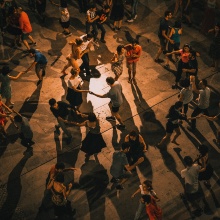We have all heard of salsa, some may think that it is only a gastronomic element, but many others will also know that it is the genre of joy, a gift from Latin America to the world. Being a music that does not need to be understood to be enjoyed.
Historical background
To better enjoy a genre as diverse as salsa, it is necessary to know its origins. This is a music that was born in the 1960s and 1970s among Cuban and Puerto Rican immigrants in New York City, from Cuban popular music. Among its relatives are the mambo, Cuban son and Latin jazz.
A fundamental element within salsa is percussion, which is defined by instruments such as timbales, conga and clave. It is also possible to find melodic instruments such as piano, saxophone, trumpet and guitar, all depending on the staging of each group. These groups tend to be numerous, so it is customary to always find a leader, who directs the music throughout each song.
A fundamental record company in salsa was "Fania Records", as it was the platform where important artists such as Willie Colón, Rubén Blades and Héctor Lavoe were established. This company was created in Manhattan by musician Johnny Pacheco and businessman Jerry Masucci, who gave it the international projection that the genre needed.
The 1970's, 1980's and 1990's were fundamental for the genre due to the following events:
1970's
- It becomes a symbol of cultural identity for the Latino community in the U.S.A.
- It became popular, especially in Colombia.
1980's
- Lost fame among the Latin youth, which became more passionate about rock music.
- Expanded throughout Latin America, Europe and Asia.
1990's
- Colombian Carlos vives fuses salsa and vallenato.
- Cali, Colombia becomes the salsa capital of the world.
The main exponents of salsa worldwide have nurtured this genre and have made it immortal. Among these great artists the following stand out: Rubén Blades, Héctor Lavoe and Joe Arroyo.
Salsa in Germany
A fundamental period for salsa was the 1980s, when it became popular in such distant lands as Germany. Within the German cultural scene salsa has always had a space, as there are countless festivals and concerts throughout the country.
For those interested in learning more about the genre in Stuttgart, you can visit the bar "Havana Cafe & Cocktail Stuttgart", where you can dance not only to this music but also to a wide range of Latin genres.
Salsa at the University of Stuttgart
On the other hand, for those who still don't know the basic steps of salsa and don't want to miss out on this lively genre, I remind you that it's never too late. The University of Stuttgart offers you the opportunity to enroll in basic or intermediate salsa courses, in two possible schedules, as you can see on the website of University Sports. If you want to get an impression of how we dance salsa, you can watch this youtube video of University Sports.
I speak from experience, being a Colombian who learned to dance salsa there. The courses are quite enjoyable and range from the most basic to the most elaborate movements, where you will be able to astonish more than one curious person. This is an experience with which you will not only learn, but also relax to the sound of the beat. Here you will find a community that, like you, share the love for salsa. Will you accept to dance to the rhythm of joy?
Andrés
Comment on this article
Your email address will not be published.


